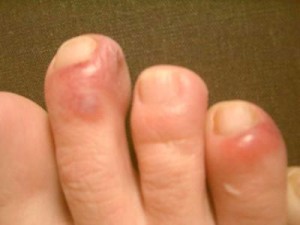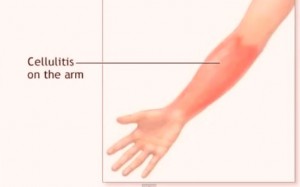What is cellulitis ?
Cellulitis is a common bacterial infection on skin and is serious in nature. It appears as a swollen, red skin of hot and tender character which generally tends to spread quickly.
Cellulitis normally occurs on lower legs, but it can happen anywhere on body including the face and can affect the outer skin, inner tissues, lymph nodes and even the blood stream. Leaving it untreated may cause rapid spread of infection, which may turn out to be life threatening. As such immediate medical care should be taken as soon as the symptoms of cellulitis appear.
Symptoms of cellulitis
Some of the signs and symptoms of cellulitis are listed below:
- Swelling
- Redness
- Tenderness
- Warmth
- Pain
- Fever
The changes noticed on the skin are closely followed by fever and in due course of time, the redness tends to expand. Sometimes, tiny red spots may occur above the increasingly red skin. On rare occasions, small blisters may occur and rupture.
Some complications that can arise from cellulitis include:
- An extreme emergency may occur when the infection spreads to deep layer of tissue known as fascial lining, resulting in necrotizing fasciitis which is a flesh eating strep.
- The increased red nature of the skin or rash may indicate a more serious problem of infection in the inner layers of skin. Once the bacteria enter the inner skin, it can enter the lymph nodes and blood stream; and from there rapidly spread all over the body. The recurrence of cellulitis can cause swelling of affected regions and cause damage to the lymphatic drainage system
Causes of cellulitis
- Cellulitis is primary caused when either one or various types of bacteria enter through a break or crack in the skin. Streptococcus and staphylococcus are the two common kinds of bacteria that cause cellulitis.
- It is essential to know that cases of serious staphylococcus infection known as methicillin-resistant Staphylococcus aureus or MRSA is on the increase.
- Even though cellulitis can occur anywhere in body, it commonly occurs on lower legs. Such areas of the body which have wounds or ulcers, recent surgery spots, dermatitis, etc. are the likely skin spots where the bacteria can enter.
- Insect or spider bites of certain category may also transmit bacteria and infection. Flaky and dry skin spots can also serve as entry points for bacteria.
Some of risk factors that can increase the vulnerability to developing cellulitis are given below:
- A weak immune system: Diseases like diabetes, HIV/AIDS, chronic kidney disease, leukemia, liver disease, etc., the use of certain medications like corticosteroids, and circulation disorders can weaken the immune system making conditions that are susceptible to infections like cellulitis.
- A known injury: A burn, fracture and a scrape or a cut can work as entry point for bacteria and cause cellulitis.
- Skin conditions: The breaks in skin caused by chickenpox, athlete’s foot, shingles and eczema like skin disorders increase the risk of cellulitis.
- Intravenous drug use: People who administer intravenous injection of illicit drugs are at greater risk of contacting cellulitis
- Lymphedema or prolonged swelling of legs or arms: The swollen tissue may crack or rupture thereby making room for bacterial infection and cellulitis.
Test and diagnosis for cellulitis
Apart from the skin appearance, the doctor may advice blood tests, wound culture and other tests to confirm the presence of a blood clot deep in the veins of legs.
Such additional tests are warranted due to the fact that, cellulitis in lower leg is usually identified by signs that include pain, warmth and swelling. Such symptoms are similar to those shown by clots that occur deep in the veins.
Treatment of cellulitis
Some lifestyle changes and home remedies that one needs to follow for cellulitis and for other infections are discussed below:
- Applying antibiotic cream or ointment as it provides protection for surface wounds
- Wash wound daily by soap and water gently during bath.
- Watch on signs of infections. Appropriate medical care should be obtained for redness, pain and infection.
Diabetic patients and people with poor circulation of blood should take additional care to prevent skin wounds by promptly treating cuts and cracks. The following are the good skin care measures:
- Regularly moisturizing the helps in its lubrication and thus prevents the skin from cracking and peeling.
- The daily inspection of feet is essential as it will result in prompt treatment of infections if present. A daily check for signs of injury is therefore necessary.
- One should take extra care while trimming finger/toe nails as doing it irresponsibly may result in injury to the surrounding skin.
- Promptly treating superficial skin infections like athlete’s foot is necessary. As the surface skin infection can easily spread, it should be given immediate medication.
- Protecting the feet and hands by wearing gloves and footwear can prevent any unnecessary infection.
Cellulitis pictures

